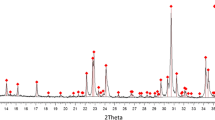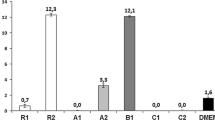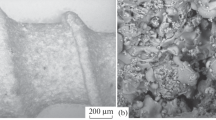Abstract
We performed experimental studies to confirm the hypothesis that cellular damages occurring around implanted biphasic bioceramics could be related to a micro-particles release because of an insufficient sintering. First, an in vitro cytotoxicity study was performed on four biphasic ceramic (BCP) samples. Without treatment of the extraction medium, a cytotoxicity was observed, although after centrifugation this cytotoxicity disappeared in all samples. Second, micro-particles of hydroxyapatite (HA), β-tricalcium phosphate (β-TCP) and 40% β-TCP/60%HA mixture were used for a cell inhibition study. A decrease of cell viability was observed with the increase in particles concentration. At 10 000 particles per cell, the viability and proliferation were completely inhibited. Third, HA, β-TCP and BCP ceramic granules were implanted in rabbit femoral cavities for 12 weeks. No degradation of HA granules was observed. The degradation was higher for β-TCP (40%) than for BCP (5%). On the other hand, new bone formation was significantly higher for β-TCP (21%) and HA (18%) than for BCP (12%). More micro-particles were formed around BCP granules than around β-TCP, and phagocytised by macrophages. The release of ceramic micro-particles could be related to the sintering process. BCP ceramic have to be sintered at only 1160 °C. Consequently, HA micro-particles of BCP ceramic are incompletely sintered and easily released after immersion or implantation. The micro-particles could be at the origin of local inflammation and cell damage and could perhaps modify osteogenesis. Attention must be paid to this problem especially with BCP ceramics because of the sintering difficulties of this bioceramic.
Similar content being viewed by others
References
A. Piattelli, A. Scarano and C. Mangano, Biomaterials 17 (1996) 1767.
J. Wiltfang, K. A. Schlegel, S. Schultze-Mosgau, E. Nkenke, R. Zimmermann and P. Kessler, Clin. Oral. Implants Res. 14 (2003) 213.
S. Altermatt, M. Schwobel and J. P. Pochon, Eur. J. Pediatr. Surg. 2 (1992) 180.
M. Furusawa, K. Nakagawa and Y. Asai, Bull. Tokyo Dent. Coll. 32 (1991) 111.
J. L. Saffar, M. L. Colombier and R. Detienville, J. Periodontol. 61 (1990) 209.
J. X. Lu, A. Gallur, K. Anselme, B. Flautre, M. Descamps, B. Thierry and P. Hardouin, J. Biomed. Mater. Res. 42 (1998) 357.
J. X. Lu, M. Descamps, J. Dejou, G. Koubi, P. Hardouin, J. Lemaitre and J. Proust, ibid. 62 (2002) 408.
C. P. Klein, K. De Groot, A. A. Driessen and H. B. Van Der Lubbe, Biomaterials 7 (1986) 144.
G. Daculsi, R. Z. Legeros and D. Mitre, Calcif. Tissue Int. 45 (1989) 95.
C. P. Klein, K. De Groot, A. A. Driessen and H. B. Van Der Lubbe, Biomaterials 6 (1985) 189.
Author information
Authors and Affiliations
Rights and permissions
About this article
Cite this article
Lu, J., Blary, MC., Vavasseur, S. et al. Relationship between bioceramics sintering and micro-particles-induced cellular damages. Journal of Materials Science: Materials in Medicine 15, 361–365 (2004). https://doi.org/10.1023/B:JMSM.0000021102.68509.65
Issue Date:
DOI: https://doi.org/10.1023/B:JMSM.0000021102.68509.65




